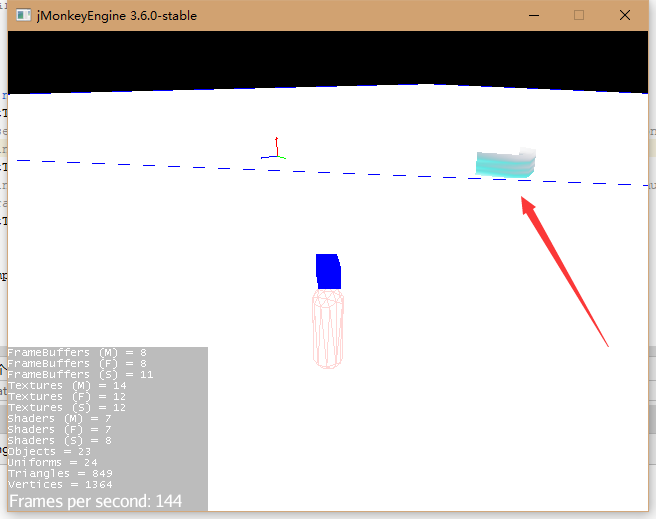I need to deal with other things in my life, so I’m a little late in replying, so sorry.
The code is written by @JhonKkk,Unfortunately I can’t ask him for specifics,He seems to be Closed cultivation,The last message left is that it will return in 2026。
So I can only ask this question in the community.
So you think this trailing should be added to the world space and not the local space?
/*
* To change this license header, choose License Headers in Project Properties.
* To change this template file, choose Tools | Templates
* and open the template in the editor.
*/
package mygame.ctrl;
import com.jme3.export.InputCapsule;
import com.jme3.export.JmeExporter;
import com.jme3.export.JmeImporter;
import com.jme3.export.OutputCapsule;
import com.jme3.material.Material;
import com.jme3.material.RenderState;
import com.jme3.math.Vector3f;
import com.jme3.renderer.RenderManager;
import com.jme3.renderer.ViewPort;
import com.jme3.scene.Spatial;
import com.jme3.scene.control.AbstractControl;
import com.jme3.scene.control.Control;
import com.jme3.scene.Node;
import java.io.IOException;
import trailing.TrailingObject;
/**
*
* @author JhonKkk
*/
public class TrailingCtrl extends AbstractControl {
private Spatial mTrailingSpatial;
/**
* @return the trailingTagName
*/
public String getTrailingTagName() {
return trailingTagName;
}
/**
* @param trailingTagName the trailingTagName to set
*/
public void setTrailingTagName(String trailingTagName) {
this.trailingTagName = trailingTagName;
}
private String trailingTagName = "trailingNode";
/**
* @return the enableTrailing
*/
public boolean isEnableTrailing() {
return enableTrailing;
}
/**
* @param enableTrailing the enableTrailing to set
*/
public void setEnableTrailing(boolean enableTrailing) {
this.enableTrailing = enableTrailing;
}
/**
* @return the length
*/
public float getLength() {
return length;
}
/**
* @param length the length to set
*/
public void setLength(float length) {
this.length = length;
}
/**
* @return the trailingMaterial
*/
public Material getTrailingMaterial() {
return trailingMaterial;
}
/**
* @param trailingMaterial the trailingMaterial to set
*/
public void setTrailingMaterial(Material trailingMaterial) {
this.trailingMaterial = trailingMaterial;
}
//Any local variables should be encapsulated by getters/setters so they
//appear in the SDK properties window and can be edited.
//Right-click a local variable to encapsulate it with getters and setters.
private TrailingObject mTrailingObject;
private Material trailingMaterial;
private boolean mIsFirst = true;
private boolean enableTrailing = false;
private float length = 5.0f;
public TrailingCtrl(){
mTrailingObject = new TrailingObject();
mTrailingObject.setTagSpatial(spatial);
mTrailingObject.setup();
}
@Override
protected void controlUpdate(float tpf) {
//TODO: add code that controls Spatial,
//e.g. spatial.rotate(tpf,tpf,tpf);
if(trailingMaterial != null && mIsFirst){
mIsFirst = false;
mTrailingObject.mTrailingGeometry.setMaterial(trailingMaterial);
trailingMaterial.getAdditionalRenderState().setFaceCullMode(RenderState.FaceCullMode.Off);
trailingMaterial.getAdditionalRenderState().setBlendMode(RenderState.BlendMode.Alpha);
((Node)spatial).attachChild(mTrailingObject.mTrailingGeometry);
if(mTrailingSpatial == null){
mTrailingSpatial = ((Node)spatial).getChild(trailingTagName);
}
}
if(trailingMaterial != null && enableTrailing){
mTrailingObject.setTagSpatial(mTrailingSpatial);
// System.out.println("localtion:" + spatial.getLocalTranslation());
mTrailingObject.setTrailingVec(spatial.getLocalTranslation().add(spatial.getLocalRotation().getRotationColumn(1).mult(length)), spatial.getLocalTranslation());
// mTrailingObject.setTrailingVec(new Vector3f(0, 10, 0), new Vector3f(0, 0, 0));
mTrailingObject.setTrailing(true);
//开始采样
mTrailingObject.sampling((long) (tpf * 1000L));
}
}
@Override
protected void controlRender(RenderManager rm, ViewPort vp) {
//Only needed for rendering-related operations,
//not called when spatial is culled.
}
public Control cloneForSpatial(Spatial spatial) {
TrailingCtrl control = new TrailingCtrl();
//TODO: copy parameters to new Control
return control;
}
@Override
public void read(JmeImporter im) throws IOException {
super.read(im);
InputCapsule in = im.getCapsule(this);
trailingMaterial = (Material) in.readSavable("trailingMaterial", null);
setEnableTrailing(in.readBoolean("enableTrailing", false));
length = in.readFloat("length", 5.0f);
trailingTagName = in.readString("trailingTagName", null);
//TODO: load properties of this Control, e.g.
//this.value = in.readFloat("name", defaultValue);
}
@Override
public void write(JmeExporter ex) throws IOException {
super.write(ex);
OutputCapsule out = ex.getCapsule(this);
out.write(trailingMaterial, "trailingMaterial", null);
out.write(length, "length", 5.0f);
out.write(isEnableTrailing(), "enableTrailing", false);
out.write(trailingTagName, "trailingTagName", "trailingNode");
//记得删掉,否则会重复写入这个对象
if(mTrailingObject.mTrailingGeometry.getParent() != null){
((Node)spatial).detachChild(mTrailingObject.mTrailingGeometry);
}
//TODO: save properties of this Control, e.g.
//out.write(this.value, "name", defaultValue);
}
}
((Node)spatial).attachChild(mTrailingObject.mTrailingGeometry);
The original version of this code is in AbstractControl which means that AbstractControl can only get to the AbstractControl target space So how do I add TrailingCtrlAbstractControl to the world space?

